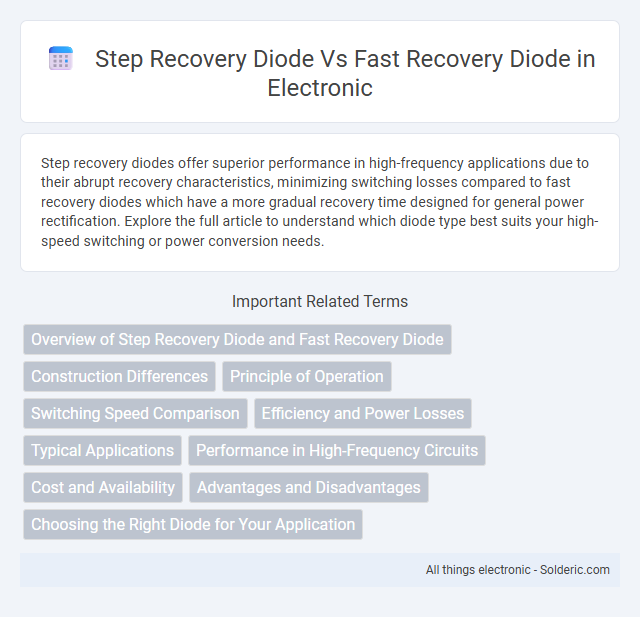Step recovery diodes offer superior performance in high-frequency applications due to their abrupt recovery characteristics, minimizing switching losses compared to fast recovery diodes which have a more gradual recovery time designed for general power rectification. Explore the full article to understand which diode type best suits your high-speed switching or power conversion needs.
Comparison Table
| Feature | Step Recovery Diode | Fast Recovery Diode |
|---|---|---|
| Recovery Time | Ultrashort, in nanoseconds | Short, typically tens of nanoseconds |
| Purpose | Pulse generation, signal sharpening | Switching and rectification in power electronics |
| Applications | High-frequency circuits, radar, pulse circuits | Switch-mode power supplies, inverters, motor drives |
| Construction | Planar PIN diode with charge storage and abrupt recovery | PN junction with reduced charge storage for fast switching |
| Reverse Recovery Behavior | Sharp recovery edge creating step waveform | Smooth but quick recovery to reverse bias |
| Transition Frequency | Very high, suitable for GHz range | Moderately high, suitable up to hundreds of MHz |
| Typical Reverse Recovery Time (trr) | Less than 1 ns | 10-100 ns |
| Cost | Higher due to specialized design | Lower and widely available |
Overview of Step Recovery Diode and Fast Recovery Diode
Step recovery diodes (SRDs) are specialized semiconductor devices designed for generating high-speed pulses and sharp transient responses, leveraging their abrupt charge depletion mechanism. Fast recovery diodes (FRDs) prioritize rapid reverse recovery time to minimize power loss and switching noise in power electronics applications. SRDs are ideal for frequency multiplication and pulse generation, while FRDs find extensive use in power rectification and high-frequency circuits requiring efficient switching.
Construction Differences
Step recovery diodes feature a specially doped p-n junction that stores charge and rapidly releases it, enabling sharp voltage transitions, while fast recovery diodes utilize a lightly doped region to minimize charge storage and reduce reverse recovery time. The unique doping profile in step recovery diodes creates a charge storage effect crucial for pulse generation, contrasting with the fast recovery diode's design aimed at quick switching in power applications. Your choice depends on whether precise pulse shaping (step recovery diode) or efficient high-speed rectification (fast recovery diode) is needed.
Principle of Operation
Step recovery diodes operate by storing charge during forward bias and abruptly releasing it during reverse bias, producing a sharp voltage spike ideal for high-frequency pulse generation. Fast recovery diodes, on the other hand, minimize charge storage to quickly switch from conducting to blocking state, optimizing switching speed for power rectification and high-speed circuits. Your choice depends on whether precise pulse shaping or rapid switching is more crucial for your application.
Switching Speed Comparison
Step recovery diodes exhibit significantly faster switching speeds than fast recovery diodes, often achieving transition times in the picosecond range. Their abrupt charge storage removal enables ultra-sharp pulse generation, ideal for high-frequency applications. Fast recovery diodes typically have recovery times in the nanosecond range, making them suitable for moderately high-speed rectification but slower than step recovery types.
Efficiency and Power Losses
Step recovery diodes exhibit higher efficiency in high-frequency switching applications due to their rapid transition from conduction to cutoff, minimizing switching losses. Fast recovery diodes offer improved performance over standard diodes but generally have higher power losses compared to step recovery diodes because of slower recovery times. Selecting step recovery diodes reduces switching energy dissipation, leading to lower overall power losses and enhanced circuit efficiency.
Typical Applications
Step recovery diodes are typically used in frequency multipliers, pulse generators, and harmonic generation due to their ability to produce sharp voltage transitions and high-frequency switching. Fast recovery diodes find common applications in power rectification, switching power supplies, and inverter circuits where rapid recovery time minimizes switching losses and improves efficiency. Both diode types are integral in high-speed electronics but serve distinct roles based on their recovery characteristics and response times.
Performance in High-Frequency Circuits
Step recovery diodes excel in high-frequency circuits by generating sharp voltage transitions and efficient pulse shaping, making them ideal for frequency multiplication and waveform generation. Fast recovery diodes offer quicker reverse recovery times than standard diodes, reducing switching losses and improving efficiency, but they may not achieve the ultra-fast transition edges of step recovery diodes. Your choice depends on whether your application demands precise pulse generation or balanced switching performance in RF and microwave circuits.
Cost and Availability
Step recovery diodes typically have a higher cost due to their specialized manufacturing process and limited production volume compared to fast recovery diodes, which are mass-produced and more widely available. Fast recovery diodes benefit from broad market demand, increasing their availability and reducing unit prices in various electronic applications. The niche usage of step recovery diodes in specific high-frequency circuits results in lower availability and comparatively higher price points.
Advantages and Disadvantages
Step recovery diodes offer superior switching speeds and sharper pulse edges, making them ideal for high-frequency applications like RF circuits. However, they tend to have higher cost and lower power handling capabilities compared to fast recovery diodes. Fast recovery diodes provide better efficiency and robustness for power rectification and switching, but their slower recovery time limits performance in ultra-high-frequency uses.
Choosing the Right Diode for Your Application
Step recovery diodes excel in high-frequency pulse generation due to their abrupt transition from conduction to cutoff, making them ideal for microwave and RF applications. Fast recovery diodes offer rapid switching with minimal charge storage, which suits power rectification and inverter circuits where efficiency and reduced switching losses matter. Your choice depends on whether your application prioritizes ultra-fast pulse shaping or efficient, fast switching in power electronics.
Step recovery diode vs Fast recovery diode Infographic

 solderic.com
solderic.com